Join us on an adventure across the Apalachicola Lowlands, home to an incredible diversity of carnivorous plants and other wildflowers. EDITED APRIL 2024! I visited an additional couple of sites and added photos below.
The shoot, technically, was over. Fellow WFSU Ecology Blogger Dani Davis and I had come for frosted flatwoods salamander larvae footage, and we shot our fill. Look for that segment later.
Anyhow, I had driven all the way from Tallahassee. We were at a US Forest Service facility deep in the Apalachicola National Forest, not far from the salamander’s habitat. When we filmed FWC biologist Pierson Hill collecting eggs in December, the animal’s ephemeral wetland breeding ponds were dry. But there’d been a good amount of rain by late March. It was a great opportunity to film the ponds full, to illustrate the wet/ dry cycle of these dynamic wetlands. After all, the frosted’s ecology is bound to it.
So I wanted to get some full pond footage. And also, I’d been seeing flowering carnivorous plants all over Facebook. There were likely to be some around these wetlands… so maybe I wouldn’t have been opposed to some additional exploring.
Pierson gave me the location of a wetland along County Road 379 near Sumatra. And since I’d be not too far away, Dani gave me the location of a recently burned pitcher plant bog. It ended up being a longer shoot day than I had expected, but in the best possible way.
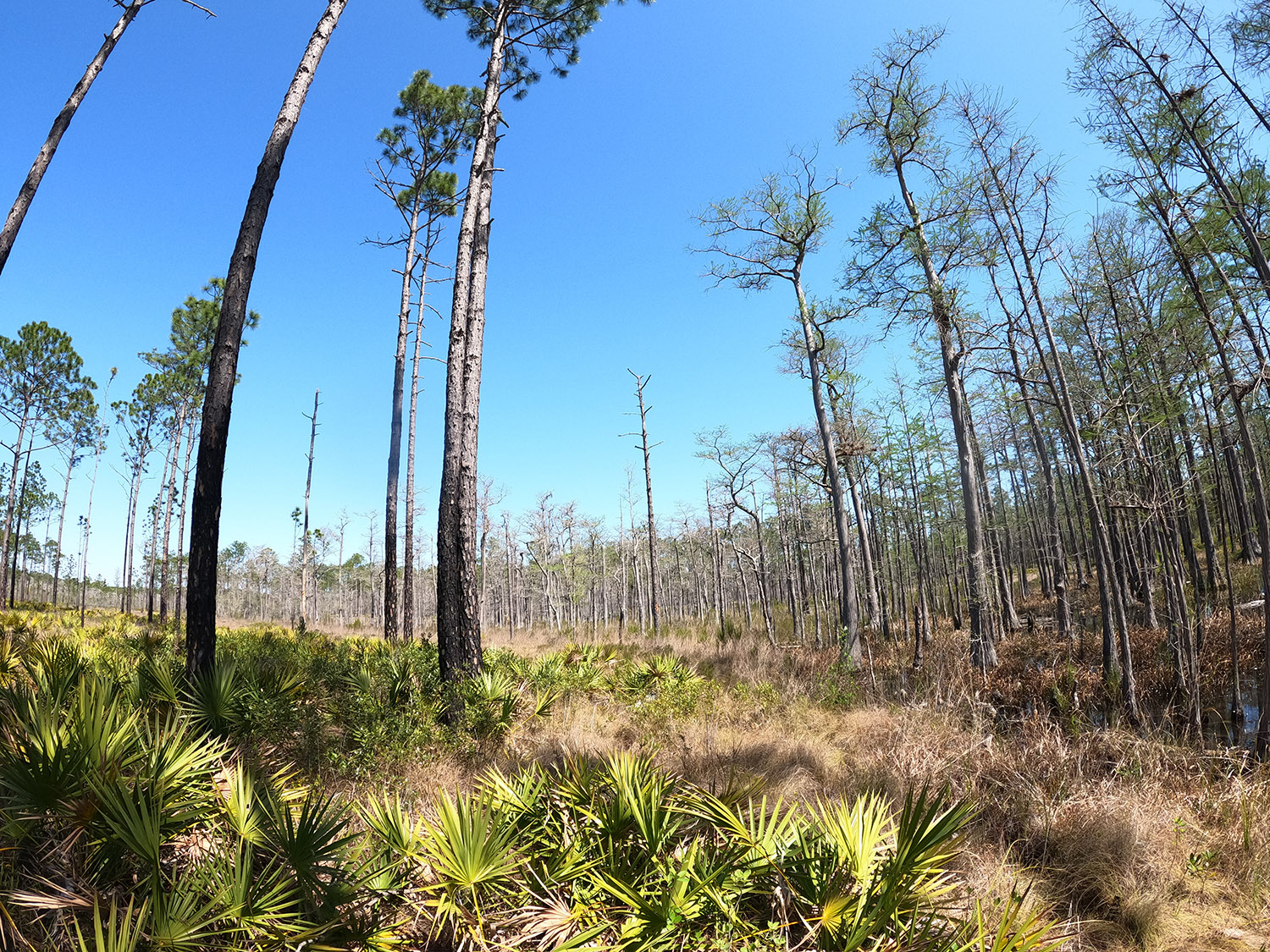
By the Ephemeral Wetland, a Rare Carnivorous Plant
First thought- I should have brought my muck boots. When it comes to those “I’ll get a few shots after” excursions, I get to thinking that I’ll be in and out. Like maybe I could just shoot a few shots from the car on the way home. No, no, no. I’m in the forest with a camera. I’m going to wander.
To set the scene, let’s look at the banner image above. On the left, a well-burned longleaf habitat. Sparse trees, the palmettos low to the ground. No large shrubs. To the right, a slight dip in elevation, where water collects. Here, cypress trees and grasses grow (compare this to the treeless ephemeral wetlands of the Munson Sandhills, which host different amphibians).
Past the wetland, I saw a line of densely packed hardwood trees lining a creek. At the base of this tree line, I saw fluorescent green specks. Pitcher plants! I started to head over.
Pitcher Plants and Sundews, Too
Longleaf ecosystems come in a few different varieties. You have plants common to all of them, like longleaf pine and wiregrass. But different conditions mean different understory plants. Here, I found little paths in the grass, starting by the road; I was obviously not the first visitor here.
A thin layer of water laid over the exposed muck in these grooves. These are mesic flatwoods, which hold standing water at times. And growing in this wet muck, I saw sundews:
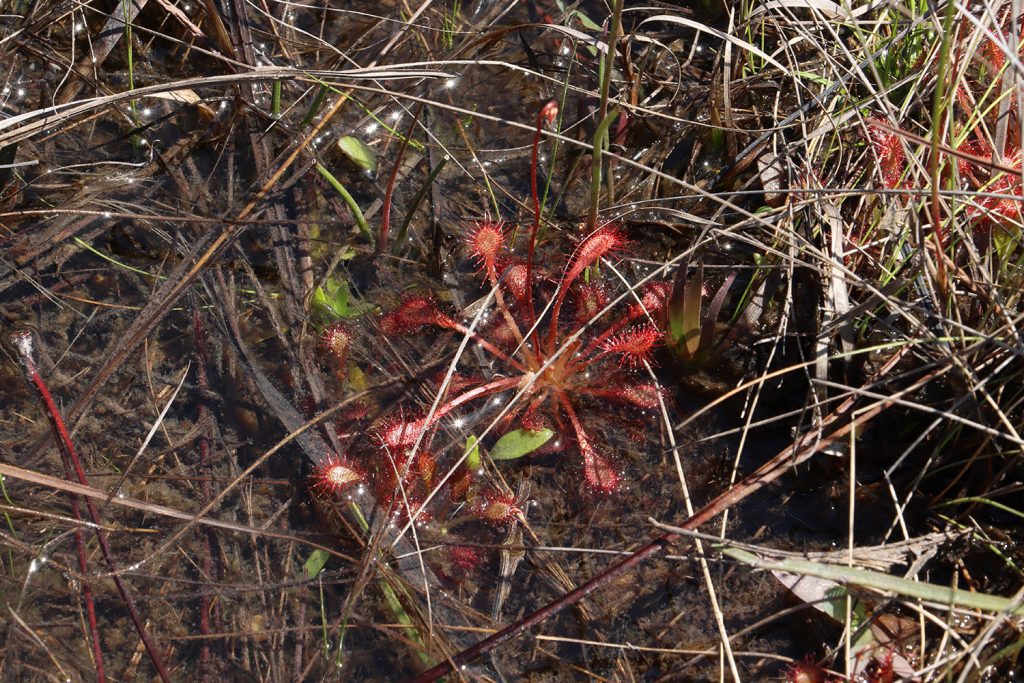
Before I left the USFS work center, Dani and Pierson had said that butterworts had all but lost their flowers, and that sundews were starting to shoot up buds. Here we see a sundew starting to bud. To see a sundew flower, check out this post on the rare plants of the St. Joseph Bay Buffer Preserve.
Sundews and butterworts shoot their flowers high above their leaves- those are for their pollinators. Down below, the sticky leaves await other insects- those that will become trapped and feed the plant.

When I got to the tree line, it took me a second to make sense of what I was seeing.

I had never seen pitcher plant leaves- their pitchers- dead and grey like this. Thinking back, I had never been in this kind of environment at this time of year. I saw something new to me; the pitchers die, flowers shoot up in the early spring, followed by the new pitchers.

A Single Flowering Butterwort
Pitcher plants catch the eye, but it’s always worth looking down for the smaller plants. This is true of all longleaf ecosystems; they’re incredibly diverse, and frequent fire creates space where smaller- sometimes rare- plants can thrive.
Near the pitcher plants, I saw this:

I’m not a butterwort expert, but I realized that I had just passed the Apalachicola Lowlands Preserve before pulling over. Last year, Ryan Means of the Coastal Plains Institute showed me a few rare plants there. The rarest? A butterwort with neon green leaves.
So, here I saw neon green leaves. Godfrey’s butterwort is found in a handful of central Florida panhandle counties, with the largest concentration here in the Apalachicola Lowlands region.
As Dani and Pierson said, butterworts had mostly dropped their flowers. This was, in fact, the only butterwort flower I would see all day. What luck! The leaves of different butterwort species are similar, though they come in different shades of red and green. The flowers of the local species are all much more easily distinguished from one another.

Pierson confirmed the identity of this plant. He said they “have responded well at several wetlands that have been restored and burned for flatwoods salamanders.”
Frequent fire keeps ephemeral wetlands from being crowded by gum trees, making space for the sheltering grasses needed by those increasingly rare salamanders. In the adjacent flatwoods, fire makes space for this rare plant. Godfrey’s butterwort is Federally listed as Threatened.

A Pitcher Plant Bog Responds to Fire
Next, I drove a while to Dani’s spot. I had been just north of Sumatra on County Road 379, which connects with State Road 65 in town. SR 65 is a wildflower corridor, world renowned for the carnivorous plants that line the road and surrounding forests. If you geek out on pitcher plants and other wildflowers, it can be a distracting drive.
After a thirty-minute drive, I found the correct forest road and took the turns as instructed. The spot was familiar; I first came here years ago with Dr. Tom Miller, Dani’s faculty advisor. This time, I was able to see the forest about a month after it had been burned. A month is all it took for that new growth in the photo above to carpet the understory. The pleasant fragrance of recently burned plant matter stayed with me through the drive home.
My last visit here was in mid-May. From March through May, each of our area’s carnivorous plants starts to bloom. As you might gather from Dani and Pierson’s comments, and what we’ve seen so far, different species bloom at different times of spring, with some overlap. In late March, The Tracey’s sundews that were conspicuous on my last visit were yet to be seen.
If you want to learn about the ecology of carnivorous plants here, I’d watch that piece with Dr. Miller. It provides a good background for the observations I captured on this trip.
Palmettos Respond to Fire
Fire-adapted plants often start growing within a day or two of being burned completely down to their roots. I’ve seen bright green wiregrass with singed tips a few days after a burn. I’ve also seen singed-tipped palmettos growing. But not like this:

I found it curious, so I did some Googling and found a US Forest Service page on saw palmettos (Serenoa repens). It said:
Saw palmetto responds to fire by sprouting soon after fire. Drawing on carbohydrate stores in rhizomes, it initiates leaf production and vegetative production, increasing stem density. The response is so strong that winter-burned saw palmetto will break winter dormancy and produce leaves and fruit out of season.
US Forest Service Plant Database entry
Dani said these woods burned on February 19, a little over a month before. A winter burn. Saw palmettos usually produce fruit in the summer, but it seems that this winter burn started the process a few months early.
The Bearded Grasspink
Making my way down the forest road, I start making out flecks of pink and bright yellow/ green. The same conditions favorable to carnivorous plants- wet areas that burn- are also favorable to orchids.

The bearded grasspink is a Coastal Plain endemic. The Coastal Plain is a bioregion encompassing the American southeast, which had historically been dominated by longleaf pine ecosystems.

Chapman’s butterwort (Pinguicula planifolia)
This spot has a higher diversity of carnivorous plants than the last- this is why Dr. Miller uses it as a study site. There were plenty of sundews here as well, and a different species of butterwort:
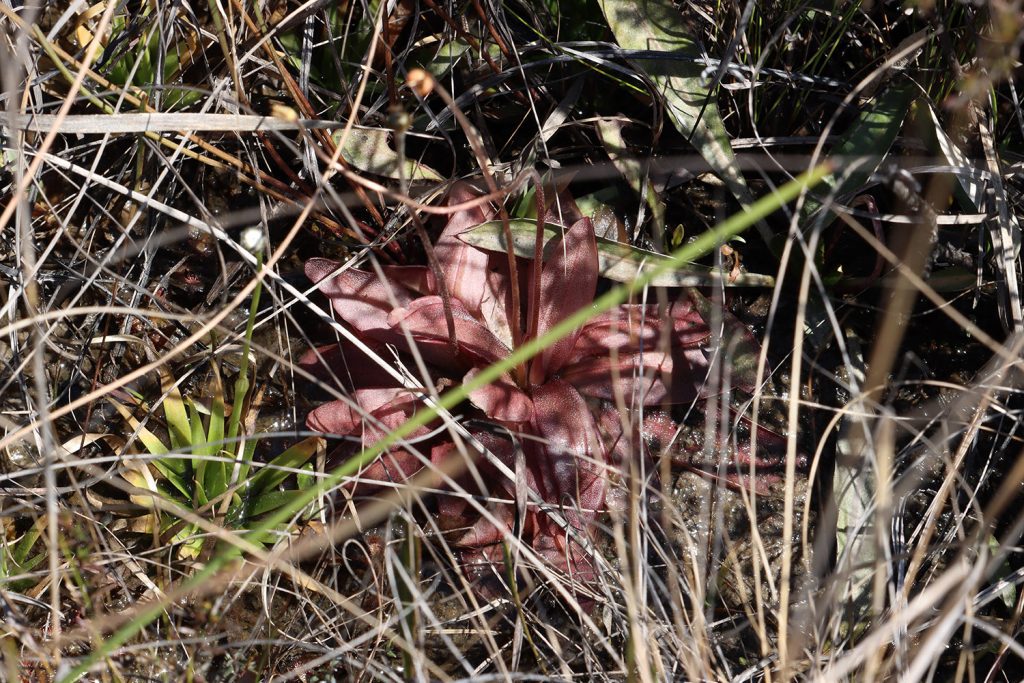
This butterwort species ranges from the Apalachicola River corridor to the Mobile River in Alabama. I don’t know if the stalk is a flower starting to bud or after the flower has faded.
Burke’s pitcher plant (Sarracenia rosea)

Again, we see new pitcher plant flowers popping up where the pitchers have been spent. This is Burke’s pitcher plant, which is Federally listed as Near Threatened. That’s two Federally listed carnivorous plants on the day.

You can see that the edges of these leaves have been singed. The leaves weren’t altogether destroyed, so maybe this particular spot was wet then?
Yellow Pitcher Plant (Sarracenia flava)

Looking at the base of those pitcher plants, they had been burned down, and this growth occurred within the last month or so. It’s a little further ahead than the yellow pitcher plants in the last spot, with both flowers and some skinny new pitchers.

These are at the same stage as the pitchers at the last site, only last year’s pitchers have been burned away.

This single pitcher has fully formed, and we can see its “red throat.” This is a variety of yellow pitcher plant known as a cutthroat pitcher plant (Sarracenia flava var. rugelii).

This bog is located where the flatwoods meet a creek that flows into the New River, which in turn flows into the Carrabbelle River. The creek at our last stop flows into the Apalachicola River. Among the dense hardwoods around the creek, we see clusters of pitcher plants.

You can see from the hardwood leaves how fire reached into the floodplain of the creek. In February when this spot burned, conditions were dry enough to let fire penetrate. But the area had once been wet enough, for long enough, to protect those hardwoods from fire and allow them to grow larger than shrubs.
This is the dynamic in which carnivorous plants thrive. They are semi-aquatic plants, and fire-adapted as well.

A well-visited bog, with Venus flytraps
Added April, 2024
It had been a couple of years since I last visited a wet prairie in the spring, and thankfully, another story now leads me back. That story is on Leon County 4H, and the outdoors and ecology education they provide kids. Every month or two, they take field trips. If I need to capture images of kids in nature, where better than in the pitcher plant bogs of the Apalachicola Lowlands?

The field trip leaders, Marina Meertz and Charlie Baisden, scouted locations last week. We’re going to two places, the first of which has Venus flytraps. It seems like a plant designed to entertain children, with toothy mouths that bite whatever lands in them. They thrive in these bogs, but they’re not from here. We’ll revisit that story momentarily. First, let’s see what other plants are on the way to the flytraps.

Mark Tancig, UF/IFAS Extension agent for Leon County, is along on this field trip. The Extension runs the 4H program, and he’s here to lend his plant expertise, as he often does on the Ecology Blog. He spots a couple splashes of orange: cinnamon ferns.
This is a leptosporangiate fern. That impressive word means these ferns make both reproductive and non-reproductive fronds. The non-reproductive fronds look like those of the ferns with which most people are most familiar. The spore-covered fronds are flashy, almost like an animal trying to attract a mate.
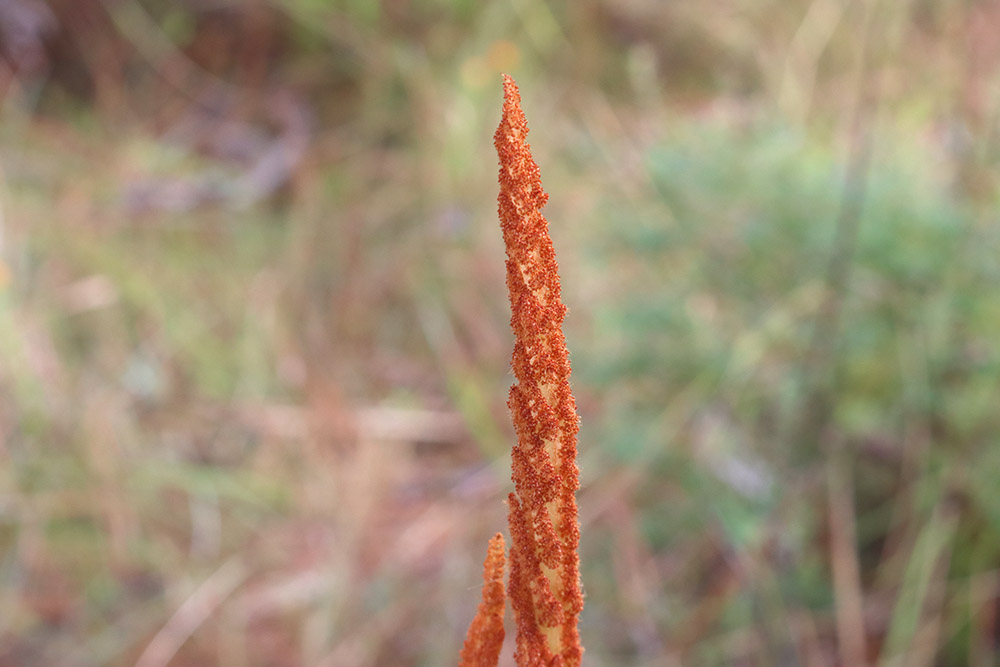
Here’s a closer look. The non-reproductive ferns have not yet sprouted.
Peaking out from the grass, we see our first carnivorous plant.

When scouting, Marina and Charlie found quite a few wildflowers, including many of the carnivorous plants you’d expect to see here. But they didn’t see any butterworts. Butterwort leaves lie low to the ground, and the grasses here have gotten tall. In early April, they have mostly lost their flowers. A sharp pair of eyes spots this yellow flower peeking out from the grass. A yellow butterwort.


Again, butterworts keep their flowers high above their sticky leaves. What good would it do to snare a bee carrying pollen to the next butterwort flower? Yellow butterworts are listed as Vulnerable in Florida.

When they’re not in bloom, most carnivorous plants are hard to spot in tall grass. That’s fine for them; small insects will still crawl along the ground and perhaps find themselves on something sticky. Many of the ones we see are on the muddy highways that traverse this prairie. The bog is not far from the road, and it has Venus flytraps. People come here, but they seem to stick mostly to these walkways. It’s destructive, but it could be more so.

Because many of the carnivorous plants we see are in these walkways, some have been trampled. There are eight kids on the field trip, and four adults to supervise them. The adults keep the kids walking single file, following the largest ruts when we can.
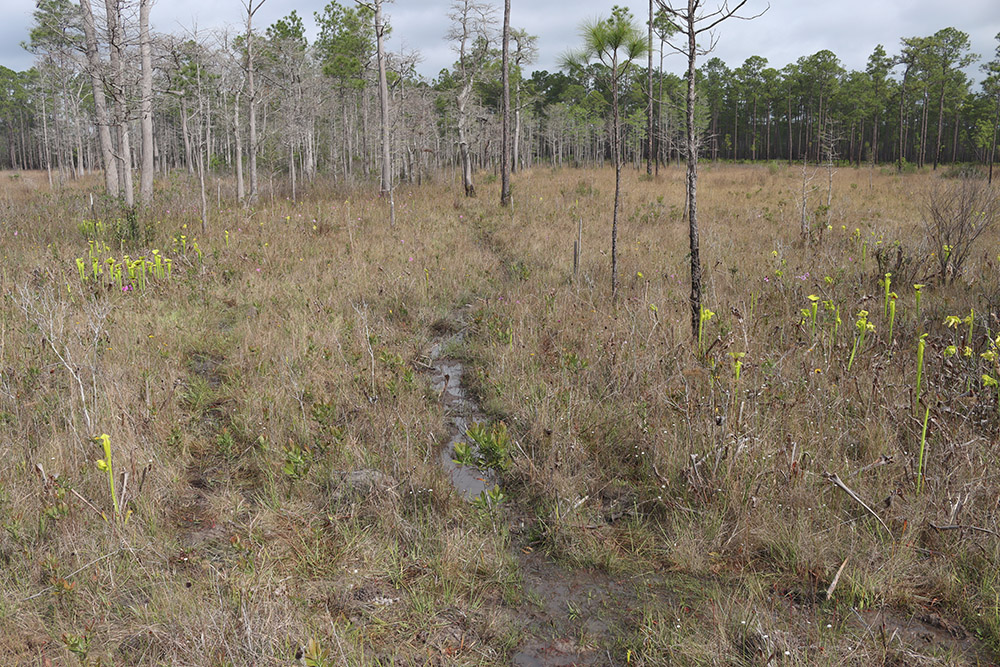
The main attraction: Venus flytraps
One of the low-lying carnivorous plants we find in these ruts is a large part of why we’re here.

The sticky threads to the left of the flytrap are dewthreads, another carnivorous plant. You can also see tall stems growing from the flytrap leaves: it’s getting ready to bloom.
A close relative of sundews, Venus flytraps are native to just two states: South and North Carolina. They were deliberately planted in north Florida bogs, by someone. That someone’s intent is a matter of debate. They figured, correctly, that this new habitat location would suit it. But were they trying to help a plant that had found itself federally listed as Vulnerable, or were they going to start a nursery, and sell the plants? Even in this introduced location, its listing protects the Venus flytrap. It was illegal to bring it here, and yet it is still illegal to take it from here.
The kids couldn’t resist triggering the leaves to clamp shut. I had thought that once they closed, they stayed closed. Apparently, if a flytrap leaf closes and it doesn’t sense weight inside of it, it reopens within 12 hours.
Other plants we saw at site 1



The pitcher plant leaf is known as a pitcher, and it’s a death trap for many insects. Here, a well-camouflaged spider makes the hood of the leaf equally lethal.

Site 2: an abundance of pitcher plants (and other treasures, too)
The second site looks less disturbed. A small creek runs through it, draining into a tupelo swamp along the Apalachicola River. Fire here reduces the growth of woody plants that would clutter the open, grassy habitat in which carnivorous plants and other rare and specialized flowers thrive. If fire were suppressed, those woody plants would grow and drink more water, depriving the creek and the swamp. Tupelo swamps are a critical source of nutrients for the Apalachicola Bay estuary. A watery thread connects the remarkable habitats of the Apalachicola River basin.

I am so taken by this picturesque bog that I don’t notice the field trip has moved on. When I see where they have gone, my jaw drops.
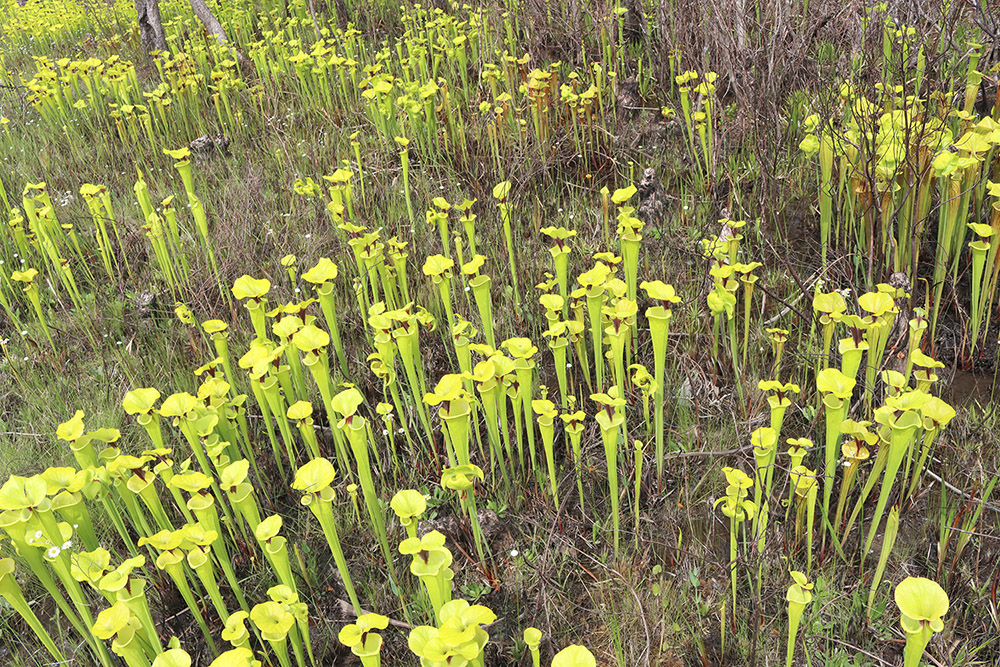
Our time is limited and the kids need lunch soon. We spend a good amount of time here, but it doesn’t feel like enough. I could photograph this bog all day.
Tearing myself away from the pitcher plants, I find a few other plants of interest.

If you scroll up slightly to the Venus flytrap photo, you’ll see dewthreads growing alongside them. Dewthread is another name for the thread-leaved sundew, or Tracy’s sundew. This is the only dewthread flower we see today; their bloom season is just starting. Another plant that is federally listed as Vulnerable.
Other wet prairie plants and animals
Both sites have colonies of an animal I associate more with swamps than bogs.

These are some of the largest crawfish mounds I have ever seen. Bogs are a transitional place, an ecotone between fire-dependent longleaf pine savannas and wet, swampy areas. Carnivorous plants thrive in this environment, which can be wet or dry. They can be wet enough to support large crawfish colonies, and at other times dry enough to burn.

A common sight in wet savannas is Osceola’s plume. The blooms can range from white to deep red. Ryan Means tells me that the blooms start red and fade to white. The plant is highly toxic; native Americans used it to poison crows, giving it another common name: crowpoison.

This bog plant is a sedge, which is a group of plants related to grasses. They are flowering plants, as are grasses, but they don’t rely on insects to spread their pollen. I wondered about sedges with flowers that looked like flowers and found some information in a wildflower guide. The white structures around the flower resemble petals, but are not. Sedges and grasses are wind-pollinated.

Getting to Know the Apalachicola Lowlands
I’m happy I took extra time to wander these locations with a camera. I’ve been getting to know this region better lately, the Apalachicola Lowlands. It’s this area between the Apalachicola and Carrabbelle Rivers, south of that ancient coastline called the Cody Escarpment. Its flatwoods drain into the Apalachicola’s fabled tupelo swamps; they are tied to the mighty river, and are ecological marvels unto themselves.
In the coming weeks, look for that story on the frosted flatwoods salamander to see another aspect of life here. And next week, in my interview with Bruce Means about his adventures abroad, we meet a snake he described that is found entirely in the Apalachicola Lowlands region.
